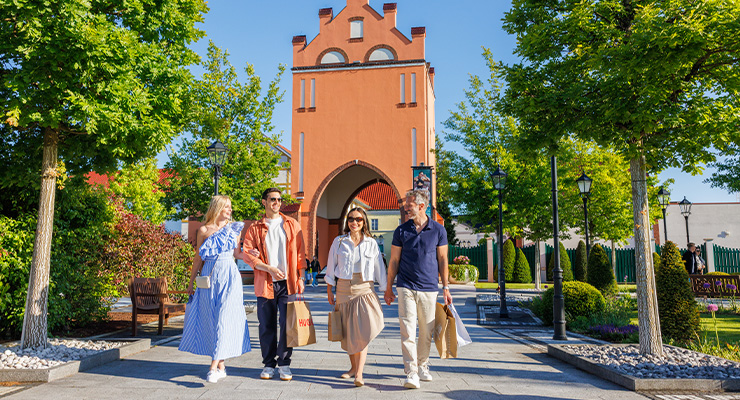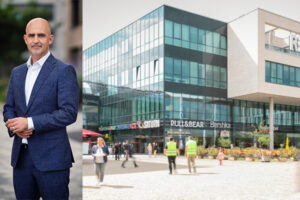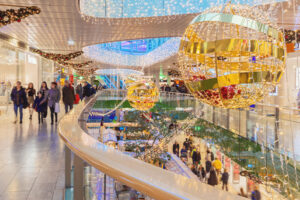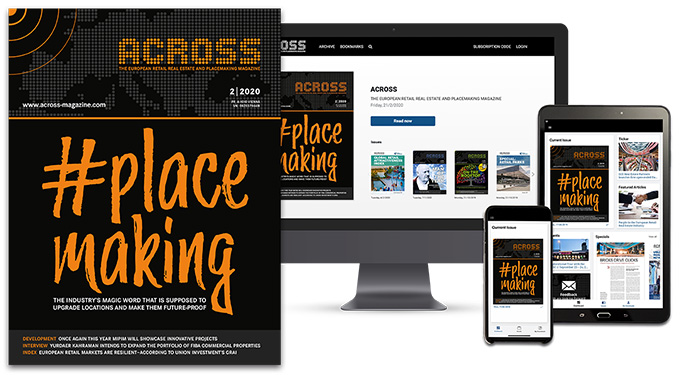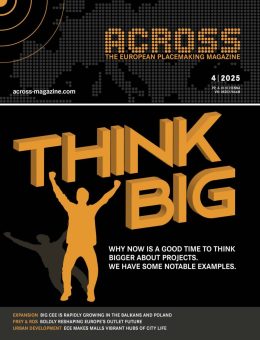Unlike traditional malls, outlet centers are conceived as open-air “villages” that blend retail with leisure, food & beverage, and cultural experiences. Their architecture, often inspired by local heritage, transforms shopping into a day-long excursion rather than a purely transactional activity. As outlet expert Ken Gunn puts it, “At an outlet center, shoppers often set aside their usual skepticism. The visit feels less transactional and more about enjoyment, premium brands in a pleasant environment that people genuinely want to spend time in.”
A SECTOR THAT DEFIES RETAIL HEADWINDS
The broader retail sector has weathered multiple storms in recent years: the acceleration of e-commerce, inflationary pressures, and shifting consumer behavior. Yet outlets have consistently bucked the trend.

Europe today counts approximately 195 outlet villages covering more than 3 million sqm of gross lettable area (GLA). What sets outlets apart is their resilience. While many mall operators grapple with vacancy rates and declining footfall, outlet centers continue to attract substantial visitor numbers and maintain robust sales growth.
As Gunn further noted in an interview with EuropaProperty: “The outlet center remains a gleaming jewel in the crown of the retail property sector and, given the projected growth, it will continue to be so… . Even better news is that there are still underserved locations and ownership opportunities that can further enhance sector returns and growth.”
WHY OUTLETS WORK: THE CORE MODEL
At the heart of the outlet proposition lies a clear, disciplined model:
- Minimum 6,000 sqm retail space designed as walkable, open-air villages.
- Lease agreements that guarantee at least 30% discounts on merchandise, ensuring genuine value for shoppers.
- Village-style architecture reflects local character and enhances the sense of place.
- Strategic accessibility is typically located along major highways and within reach of urban hubs.
- Catchment areas of at least 3 million inhabitants, often supplemented by strong tourism flows.
- Integrated leisure, F&B, and cultural programming, turning retail into a multi-dimensional experience.
This formula has proven to be both scalable and resilient. Developers and operators can replicate the concept across diverse geographies, while brands find outlets a reliable channel for monetizing surplus stock without diluting their premium positioning.
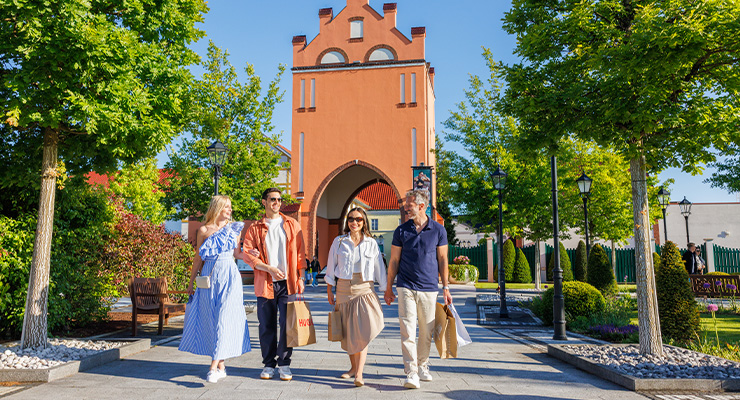
EXPERIENCE AS A DIFFERENTIATOR
The outlet format thrives because it recognizes what modern consumers increasingly demand: experience alongside value. The layout of outlet villages fosters discovery: winding streets, landscaped squares, and architecture that echoes local styles.
Dr. Caroline Lamy, CEO of CL Outlet Consulting, highlights this trend in an earlier interview with ACROSS: “The goal is to offer facilities to transform outlet centers into ‘living centers’ or ‘places of life’ and to drive footfall, especially during the week.”
Curated food & beverage offerings play a crucial role. From local specialties to international chains, dining is positioned as more than a convenience; it is part of the day out. Seasonal festivals, cultural exhibitions, and even live music amplify the sense of vibrancy, encouraging repeat visits and extending dwell time.
TOURISM AS A GROWTH ENGINE
Another structural advantage of outlets is their ability to tap into tourism flows. Many villages are strategically positioned within 90 minutes of major urban centers and near popular tourist regions. International visitors, particularly from Asia and North America, view outlet shopping as an integral part of their travel itinerary.
In some markets, tourist spending can account for up to 40% of sales, with high-spending visitors seeking both value and iconic European brands. Shuttle services, multilingual staff, and tax-free shopping options have all become standard features to serve this segment.
Lamy observes, “Today, Southern Europe is home to some of the continent’s best-performing outlet centers, a remarkable shift compared to a decade ago. The transformation is driven by more sophisticated retail strategies and changing consumer behaviors.”
OUTLOOK & IMPLICATIONS FOR RETAIL REAL ESTATE
The model exemplified by FREY and ROS illuminates trends and implications for the broader outlet-center sector:
Outlet centers are resilient: They combine value (discounted brands), experience (open air, destination), and the capacity to attract international and local customers alike.
Scale matters: As ROS grows under FREY, the combined portfolio gains negotiating power (for leases, brand attraction), economies of scale (operations, marketing), and risk mitigation across geography.
Experience & ESG are differentiators: Modern outlets are less about rows of stores and more about integrated experiences, F&B, leisure, services, social and sustainability credentials. The new development Malmö Designer Village is a poster child for that direction.
Capital is flowing into premium outlets: Investors see open-air, experience-rich retail with strong catchment & tourism foundations as a solid bet amid shifts in retail habits. The acquisition of ROS was itself significant (with valuations in the multiple billions) and shows appetite.
RESILIENCE IN TIMES OF INFLATION
In an inflationary environment where households feel squeezed, outlets benefit from their core value promise. Shoppers who may trade down from full-price luxury still aspire to premium brands, and outlets provide the perfect compromise.
For retailers, outlets offer a controlled channel to clear inventory without resorting to indiscriminate discounting online or in flagship stores. This balance supports both profitability and brand equity. As a result, even in downturns, outlets often outperform conventional retail, proving counter-cyclical resilience.
DEVELOPERS DOUBLE DOWN
Recognizing these strengths, developers continue to invest in the format. Expansion is visible across both mature and emerging European markets.
Key players in the sector highlight consistent occupancy rates above 95%, underpinned by strong demand from brands seeking reliable distribution. The rise of “off-price” divisions within major fashion houses underscores the structural maturity of the model.
THE ESG AND COMMUNITY ANGLE
Another factor contributing to outlets’ appeal is their alignment with sustainability and community values. By extending the lifecycle of products, outlets encourage more sustainable consumption patterns. At the same time, their open-air, village-style layouts often integrate landscaping, energy-efficient design, and regional architectural themes. Culturally, outlets frequently collaborate with local artists and host community events, embedding themselves as part of the regional fabric rather than being perceived as isolated shopping complexes.
LOOKING AHEAD: OPPORTUNITIES AND CHALLENGES
The outlook for outlets remains positive, but not without challenges. Operators must continue to adapt to digital integration, ensuring seamless connections between online brand platforms and physical outlet experiences. Consumers increasingly expect personalization, loyalty apps, and click-and-collect services.
Competition is intensifying as more villages open and existing centers expand their operations. The differentiation will hinge on the quality of experience, not just the depth of discount. Outlets that continue to innovate in F&B, leisure, and cultural programming will sustain their destination appeal.
A GROWTH STORY BUILT TO LAST
In a retail landscape characterized by disruption and uncertainty, outlet shopping stands out as a resilient growth story. Its ability to combine premium brands with guaranteed value, embed shopping in village-style experiences, and harness both local and tourist demand has made outlets one of the most successful formats in European retail real estate.
With nearly 200 outlet villages across Europe and more in the pipeline, the sector shows no sign of slowing. As consumer expectations evolve, outlets will continue to adapt, but their core appeal, blending value with experience, ensures that they remain a format built to last.
At the heart of this evolution stands Frey together with ROS. With 19 premium outlet villages now under management, the group is one of Europe’s major players. FREY’s DNA and financial power, combined with ROS’s agility, create future-ready destinations that meet the changing needs of brands, shoppers, and investors.

